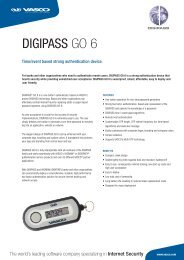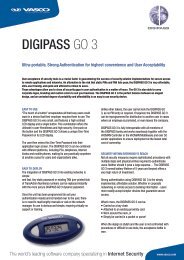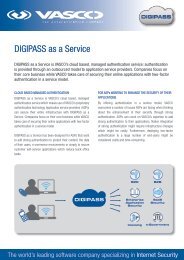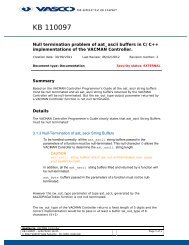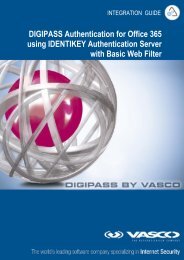Digipass Plug-In for SBR Administrator Reference - Vasco
Digipass Plug-In for SBR Administrator Reference - Vasco
Digipass Plug-In for SBR Administrator Reference - Vasco
You also want an ePaper? Increase the reach of your titles
YUMPU automatically turns print PDFs into web optimized ePapers that Google loves.
<strong>Digipass</strong> <strong>Plug</strong>-<strong>In</strong> <strong>for</strong> <strong>SBR</strong> <strong>Administrator</strong> <strong>Reference</strong> <strong>Digipass</strong> TCL Command-Line Administration<br />
14.2.2 Running a Script<br />
Using DPADMINCMD to run a script requires an administration logon to be specified with<br />
command-line parameters, unless the script itself contains a logon command.<br />
For an implicit Active Directory logon, the -i (implicit) parameter is sufficient.<br />
For a logon requiring credentials, the -u (userid) and -p (password) parameters are required.<br />
1. Open a Windows command prompt in the \Bin directory.<br />
2. Enter the following command <strong>for</strong> an implicit logon and press Enter:<br />
dpadmincmd -i scriptname<br />
3. Or, enter the following command <strong>for</strong> an explicit logon and press Enter:<br />
dpadmincmd -u userid -p password scriptname<br />
The scriptname parameter can be a file name or path and file name.<br />
If your script requires parameters, enter these after the scriptname.<br />
Example<br />
dpadmincmd -i myscript.tcl param1 param2<br />
The script file must contain a sequence of TCL commands. DPADMINCMD will first per<strong>for</strong>m the<br />
logon, and if successful, will execute each command in the script in sequence. The TCL<br />
language allows you to write simple sequential scripts or add more complex control flow,<br />
functions and so on.<br />
The script does not need to use the logoff or exit commands explicitly. DPADMINCMD will<br />
logoff the session if necessary at exit time.<br />
Character Substitution<br />
When using a non-printing ASCII character substitution (eg. \t <strong>for</strong> a horizontal tab) in a string,<br />
enclose the string in double quotes. If the string is enclosed in { }, the string will be displayed<br />
exactly as entered.<br />
eg. “Error: \t Component does not exist. \n \t \t Please check the Component name.” will be<br />
displayed as:<br />
Error: Component does not exist.<br />
Please check the Component name.<br />
Whereas {Error: \t Component does not exist. \n \t \t Please check the Component name.}<br />
will be displayed as:<br />
Error: \t Component does not exist. \n \t \t Please check the Component<br />
name.<br />
© 2006 VASCO Data Security <strong>In</strong>c. 152




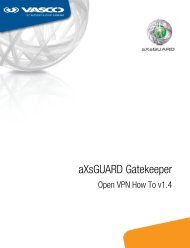
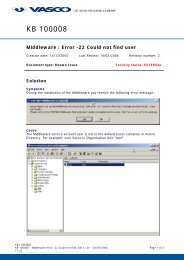
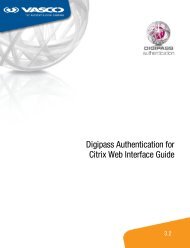
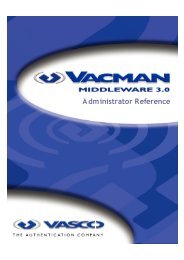
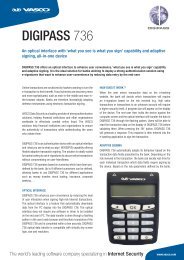
![KB [100006] - Vasco](https://img.yumpu.com/12539350/1/184x260/kb-100006-vasco.jpg?quality=85)

